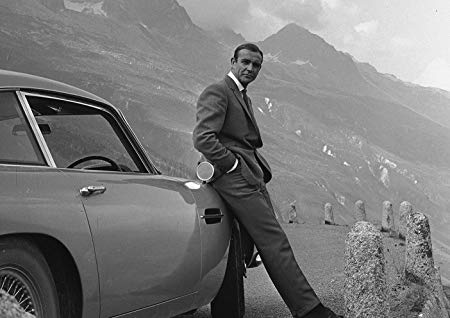The James Bond film series is best known for fast Aston Martin and Lotus sports cars (often with gadgets). But there are quite a few Bond vehicles that don’t get the heart pumping. Here are some examples:
Kerim Bey’s station wagon

In From Russia With Love, Kerim Bey sends a Rolls-Royce limousine to pick James Bond up from the Istanbul airport. Later in the movie, the head of Station T sends the Rolls (with two dummies in the back) off in another direction while he and Bond travel to a gypsy camp in a station wagon.
The modest transportation works in the context of the story. The flashy Rolls is a decoy. Bond’s journey in Kerim’s station wagon helps set up one of the key sequences of the movie. But the station wagon isn’t particularly sexy. In 1966’s The Silencers, Matt Helm (Dean Martin) also goes around in a station wagon. But Dino’s wheels include a bar (!).
James Bond’s Lincoln Continental

In Thunderball, Bond (Sean Connery) again drives the Aston Martin DB5 he had earlier piloted in Goldfinger. The fourth Bond film made by Eon Productions provided 007 a more down-to-earth set of wheels once Bond got to The Bahamas — a Lincoln Continental he drove up to the estate of Largo (Adolfo Celi). The Lincoln is only briefly seen onscreen.
Honda ATV (all-terrain vehicle)

In Diamonds Are Forever, Sean Connery’s final movie for Eon Productions, the intrepid agent infiltrates a Nevada installation owned by industrialist Willard Whyte. Bond is discovered and has to get out fast.
He first steals a “moon buggy” being developed by Whyte’s company (which is under control of Blofeld). Bond manages to get out of the moon buggy while the vehicle continues on its way. Bond then overcomes one of the Whyte security personnel, who is driving a three-wheel Honda all-terrain vehicle (or ATV).
Despite the lack of dignity, Bond drives the ATV until he can rendezvous with Tiffany Case (Jill St. John). She is waiting with a new Ford Mustang, the main product placement deal of the film.
Bond’s Ford LTD

In A View to a Kill, Bond (Roger Moore) is following Stacey Sutton (Tanya Roberts) around San Francisco in a Ford LTD. The LTD was a big, boxy Ford sedan that went out of production and is long forgotten. Presumably, in the story, it was a rental car but that’s not spelled out in the movie.
By the time of the release of A View to a Kill, the LTD was on its last legs. The model would soon be phased out in favor of the Ford Taurus.
Bond’s Lincoln Mark VII

In Licence to Kill (1989), Bond (Timothy Dalton) intends to depart Florida after Felix Leiter (David Hedison) has gotten married. Dalton’s Bond is depicted as getting ready to return his rental car. But things take a turn when Bond discovers Leiter never made his honeymoon. Bond goes rogue, doesn’t catch his flight, and instead gets back in the car to figure out what’s going on.
Bond’s Ford Mondeo

Technically, the first car driven by the Daniel Craig version of Bond was a Ford Mondeo. The automaker had redesigned the European car and arranged for it to be in 2006’s Casino Royale. The car in the film wasn’t then (and still isn’t) street-legal. Bond drives the car (or so it seems) after the agent has arrived in The Bahamas.
Many Bond fans can’t stand the Mondeo’s appearance in the movie, viewing it as an obvious commercial for Ford. The magic of cinema likely made the Mondeo appear to be traveling faster than it could, via camera angles and sound effects.
Filed under: James Bond Films | Tagged: A View to Kill, Casino Royale, Diamonds Are Forever, Ford LTD, Ford Mondeo, From Russia With Love, Honda ATV, Licence to Kill, Lincoln Continental, Lincoln Mark VII, Thunderball | 2 Comments »










